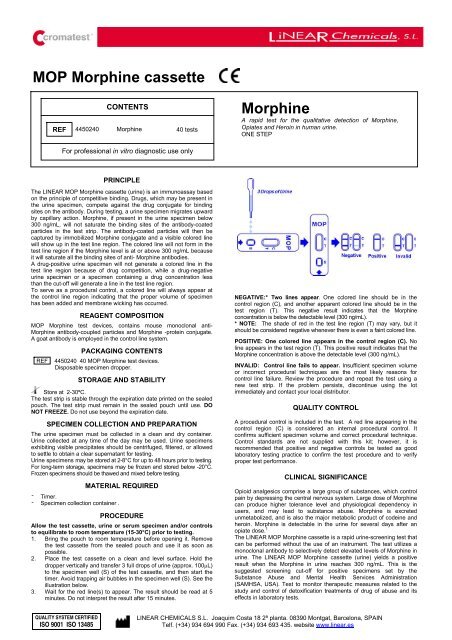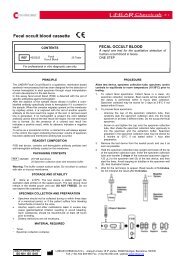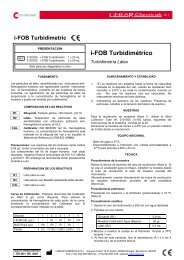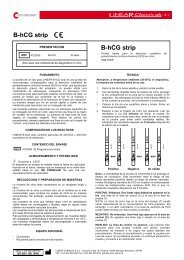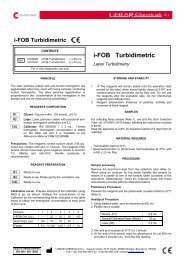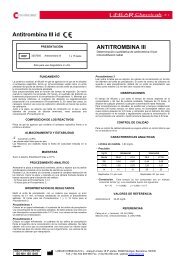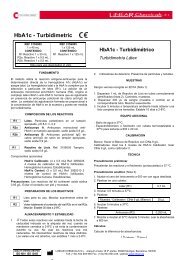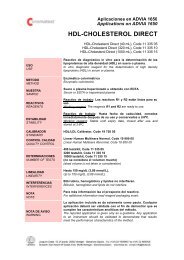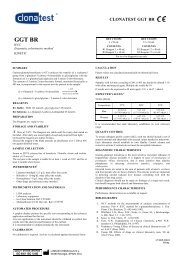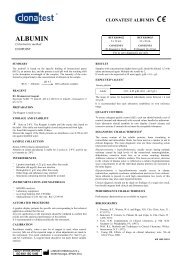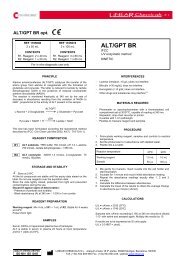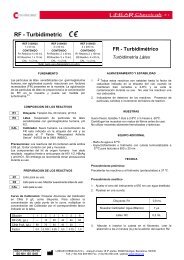MOP Morphine cassette Morphine - LINEAR CHEMICALS
MOP Morphine cassette Morphine - LINEAR CHEMICALS
MOP Morphine cassette Morphine - LINEAR CHEMICALS
Create successful ePaper yourself
Turn your PDF publications into a flip-book with our unique Google optimized e-Paper software.
<strong>MOP</strong> <strong>Morphine</strong> <strong>cassette</strong><br />
CONTENTS<br />
REF 4450240 <strong>Morphine</strong><br />
40 tests<br />
<strong>Morphine</strong><br />
A rapid test for the qualitative detection of <strong>Morphine</strong>,<br />
Opiates and Heroin in human urine.<br />
ONE STEP<br />
For professional in vitro diagnostic use only<br />
PRINCIPLE<br />
The <strong>LINEAR</strong> <strong>MOP</strong> <strong>Morphine</strong> <strong>cassette</strong> (urine) is an immunoassay based<br />
on the principle of competitive binding. Drugs, which may be present in<br />
the urine specimen, compete against the drug conjugate for binding<br />
sites on the antibody. During testing, a urine specimen migrates upward<br />
by capillary action. <strong>Morphine</strong>, if present in the urine specimen below<br />
300 ng/mL, will not saturate the binding sites of the antibody-coated<br />
particles in the test strip. The antibody-coated particles will then be<br />
captured by immobilized <strong>Morphine</strong> conjugate and a visible colored line<br />
will show up in the test line region. The colored line will not form in the<br />
test line region if the <strong>Morphine</strong> level is at or above 300 ng/mL because<br />
it will saturate all the binding sites of anti- <strong>Morphine</strong> antibodies.<br />
A drug-positive urine specimen will not generate a colored line in the<br />
test line region because of drug competition, while a drug-negative<br />
urine specimen or a specimen containing a drug concentration less<br />
than the cut-off will generate a line in the test line region.<br />
To serve as a procedural control, a colored line will always appear at<br />
the control line region indicating that the proper volume of specimen<br />
has been added and membrane wicking has occurred.<br />
REAGENT COMPOSITION<br />
<strong>MOP</strong> <strong>Morphine</strong> test devices, contains mouse monoclonal anti-<br />
<strong>Morphine</strong> antibody-coupled particles and <strong>Morphine</strong> -protein conjugate.<br />
A goat antibody is employed in the control line system.<br />
PACKAGING CONTENTS<br />
4450240 40 <strong>MOP</strong> <strong>Morphine</strong> test devices.<br />
Disposable specimen dropper.<br />
STORAGE AND STABILITY<br />
Store at 2-30ºC.<br />
The test strip is stable through the expiration date printed on the sealed<br />
pouch. The test strip must remain in the sealed pouch until use. DO<br />
NOT FREEZE. Do not use beyond the expiration date.<br />
SPECIMEN COLLECTION AND PREPARATION<br />
The urine specimen must be collected in a clean and dry container.<br />
Urine collected at any time of the day may be used. Urine specimens<br />
exhibiting visible precipitates should be centrifuged, filtered, or allowed<br />
to settle to obtain a clear supernatant for testing.<br />
Urine specimens may be stored at 2-8°C for up to 48 hours prior to testing.<br />
For long-term storage, specimens may be frozen and stored below -20°C.<br />
Frozen specimens should be thawed and mixed before testing.<br />
-<br />
-<br />
REF<br />
Timer.<br />
Specimen collection container .<br />
MATERIAL REQUIRED<br />
PROCEDURE<br />
Allow the test <strong>cassette</strong>, urine or serum specimen and/or controls<br />
to equilibrate to room temperature (15-30°C) prior to testing.<br />
1. Bring the pouch to room temperature before opening it. Remove<br />
the test <strong>cassette</strong> from the sealed pouch and use it as soon as<br />
possible.<br />
2. Place the test <strong>cassette</strong> on a clean and level surface. Hold the<br />
dropper vertically and transfer 3 full drops of urine (approx. 100μL)<br />
to the specimen well (S) of the test <strong>cassette</strong>, and then start the<br />
timer. Avoid trapping air bubbles in the specimen well (S). See the<br />
illustration below.<br />
3. Wait for the red line(s) to appear. The result should be read at 5<br />
minutes. Do not interpret the result after 15 minutes.<br />
NEGATIVE:* Two lines appear. One cclored line should be in the<br />
control region (C), and another apparent colored line should be in the<br />
test region (T). This negative result indicates that the <strong>Morphine</strong><br />
concentration is below the detectable level (300 ng/mL).<br />
* NOTE: The shade of red in the test line region (T) may vary, but it<br />
should be considered negative whenever there is even a faint colored line.<br />
POSITIVE: One colored line appears in the control region (C). No<br />
line appears in the test region (T). This positive result indicates that the<br />
<strong>Morphine</strong> concentration is above the detectable level (300 ng/mL).<br />
INVALID: Control line fails to appear. Insufficient specimen volume<br />
or incorrect procedural techniques are the most likely reasons for<br />
control line failure. Review the procedure and repeat the test using a<br />
new test strip. If the problem persists, discontinue using the lot<br />
immediately and contact your local distributor.<br />
QUALITY CONTROL<br />
A procedural control is included in the test. A red line appearing in the<br />
control region (C) is considered an internal procedural control. It<br />
confirms sufficient specimen volume and correct procedural technique.<br />
Control standards are not supplied with this kit; however, it is<br />
recommended that positive and negative controls be tested as good<br />
laboratory testing practice to confirm the test procedure and to verify<br />
proper test performance.<br />
CLINICAL SIGNIFICANCE<br />
Opioid analgesics comprise a large group of substances, which control<br />
pain by depressing the central nervous system. Large dose of <strong>Morphine</strong><br />
can produce higher tolerance level and physiological dependency in<br />
users, and may lead to substance abuse. <strong>Morphine</strong> is excreted<br />
unmetabolized, and is also the major metabolic product of codeine and<br />
heroin. <strong>Morphine</strong> is detectable in the urine for several days after an<br />
opiate dose. 1<br />
The <strong>LINEAR</strong> <strong>MOP</strong> <strong>Morphine</strong> <strong>cassette</strong> is a rapid urine-screening test that<br />
can be performed without the use of an instrument. The test utilizes a<br />
monoclonal antibody to selectively detect elevated levels of <strong>Morphine</strong> in<br />
urine. The <strong>LINEAR</strong> <strong>MOP</strong> <strong>Morphine</strong> <strong>cassette</strong> (urine) yields a positive<br />
result when the <strong>Morphine</strong> in urine reaches 300 ng/mL. This is the<br />
suggested screening cut-off for positive specimens set by the<br />
Substance Abuse and Mental Health Services Administration<br />
(SAMHSA, USA). Test to monitor therapeutic measures related to the<br />
study and control of detoxification treatments of drug of abuse and its<br />
effects in laboratory tests.<br />
QUALITY SYSTEM CERTIFIED<br />
ISO 9001 ISO 13485<br />
<strong>LINEAR</strong> <strong>CHEMICALS</strong> S.L. Joaquim Costa 18 2ª planta. 08390 Montgat, Barcelona, SPAIN<br />
Telf. (+34) 934 694 990 Fax. (+34) 934 693 435. website www.linear.es
A. Accuracy<br />
ANALYTICAL PERFORMANCE<br />
The accuracy of the <strong>LINEAR</strong> <strong>MOP</strong> <strong>Morphine</strong> <strong>cassette</strong> was compared<br />
and checked against a commercially available test with a threshold<br />
value of 300 ng/mL. 120 urine samples taken from volunteer test<br />
persons who claim to be non-consumers was examined under both<br />
tests. The results were 100% in agreement.<br />
B. Reproducibility<br />
The reproducibility of the <strong>LINEAR</strong> <strong>MOP</strong> <strong>Morphine</strong> <strong>cassette</strong> was verified<br />
by blind tests performed at a four different locations. All 60 utilized<br />
samples with a MOR-concentration of 150 ng/mL yielded a negative<br />
result. All 60 samples with a MOR-concentration of 600 ng/mL yielded a<br />
positive result. No significant differences were observed between test<br />
results of the different evaluation sites.<br />
C. Precision<br />
Test precision was determined by blind tests with control solutions.<br />
Controls with a MOR-concentration of 150 ng/mL yield a negative result.<br />
Controls with a MOR-concentration of 450 ng/mL provide a positive<br />
result.<br />
D. Specificity<br />
The specificity of the <strong>LINEAR</strong> <strong>MOP</strong> <strong>Morphine</strong> <strong>cassette</strong> was tested with<br />
the substances listed below, all of which can be found in a normal urine<br />
specimen. These substances were added to normal drug free urine.<br />
The following compounds with a similar chemical structure yielded a<br />
positive result at the specified concentration:<br />
COMPOUND<br />
CONCENTRATION<br />
(ng/mL)<br />
<strong>Morphine</strong> 300<br />
Codeine 300<br />
Diacetyl morphine (Heroine) 300<br />
Ethylmorphine 300<br />
Hydromorphone 1,500<br />
Hydrocodone 1,500<br />
Merperidine >100,000<br />
6-Monoacetylmorphine 300<br />
<strong>Morphine</strong>-3- β-d-glucuronide 6,000<br />
Oxycodone >20,000<br />
Oxymorphone >20,000<br />
Promethazine >250,000<br />
Rifampicine 25,000<br />
Thebaine 2,50<br />
Trimipramine >20,000<br />
Erythromycin<br />
Ethanol<br />
Furosemide<br />
Glucose<br />
Trimethobenzamide<br />
Tyramine<br />
Vitamin C<br />
NOTES<br />
1. The <strong>LINEAR</strong> <strong>MOP</strong> <strong>Morphine</strong> <strong>cassette</strong> provides only a qualitative,<br />
preliminary analytical result. A secondary analytical method must be<br />
used to obtain a confirmed result. Gas chromatography/mass<br />
spectrometry (GC/MS) is the preferred confirmatory method. 1,2<br />
2. Adulterants, such as bleach and/or alum, in urine specimens may<br />
produce erroneous results regardless of the analytical method used.<br />
If adulteration is suspected, the test should be repeated with<br />
another urine specimen.<br />
3. A positive result indicates presence of the drug or its metabolites but<br />
does not indicate level of intoxication, administration route or<br />
concentration in urine.<br />
4. A negative result may not necessarily indicate drug-free urine.<br />
Negative results can be obtained when drug is present but below<br />
the cut-off level of the test.<br />
5. Test does not distinguish between drugs of abuse and certain<br />
medications.<br />
REFERENCES<br />
1. Baselt, R.C. Disposition of Toxic Drugs and Chemicals in Man, Biomedical<br />
Publications, 1982.<br />
2. Urine Testing for Drugs of Abuse. National Institute on Drug Abuse<br />
(NIDA), Research Monograph 73, 1986.<br />
3. Thomas L. eds., Labor und Diagnose, 6. ed., TH-Books Verlagsgesellschaft,<br />
Frankfurt, 2005<br />
4. Fed. Register, Department of Health and Human Services,<br />
Mandatory Guidelines for Federal Workplace Drug Testing<br />
Programs, 53, 69, 11970, 1988.<br />
5. McBay, A.J. Clin. Chem. 33, 33B-40B, 1987.<br />
6. Gilman, A.G., & Goodman, L.S. The Pharmacological Basis of<br />
Therapeutics, eds. MacMillan Publishing, New York, NY, 1980.<br />
7. Minden, Sandra v.; Minden, Wolfgang v.; Analytik von Drogen und<br />
Medikamenten, von Minden GmbH, Moers 2002<br />
8. Warner, Ann Interference of Common Household Chemicals in<br />
Immunoassay Methods for Drugs of Abuse, Clin. Chem. 35/4, 648-<br />
651 (1989)<br />
All following listed compounds reacted negative up to a concentration of<br />
100 µg/mL.<br />
Acetamidophene<br />
Acetone<br />
Albumin<br />
Amitriptyline<br />
Ampicillin<br />
Aspartame<br />
Aspirin<br />
Atropine<br />
Benzocaine<br />
Bilirubin<br />
Caffeine<br />
Chloroquine<br />
(+/-)-Chlorpheniramine<br />
Chlorpheniramine<br />
Creatine<br />
Dexbrompheniramine<br />
Dextromethorphan<br />
4-Dimethylaminoantipyrine<br />
Dopamine<br />
Guaiacol Glyceryl Ether<br />
Hemoglobin<br />
Imipramine<br />
(+/-)-Isoproterenol<br />
Lidocaine<br />
(+)-Naproxen<br />
Oxalic Acid<br />
Penicillin-G<br />
Pheniramine<br />
Phenothiazine<br />
Phenylethylamine<br />
Procaine<br />
Quinidine<br />
Ranitidine<br />
Riboflavine<br />
Sodium Chloride<br />
Sulindac<br />
Thioridazine<br />
Trifluoperazine<br />
44502-3/0903<br />
R1.ing<br />
QUALITY SYSTEM CERTIFIED<br />
ISO 9001 ISO 13485<br />
<strong>LINEAR</strong> <strong>CHEMICALS</strong> S.L. Joaquim Costa 18 2ª planta. 08390 Montgat, Barcelona, SPAIN<br />
Telf. (+34) 934 694 990 Fax. (+34) 934 693 435. website www.linear.es


